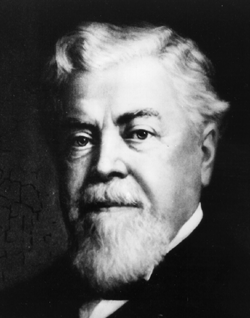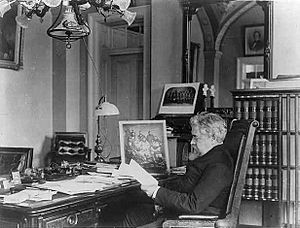John Willock Noble facts for kids
Quick facts for kids
John Noble
|
|
|---|---|
 |
|
| 18th United States Secretary of the Interior | |
| In office March 7, 1889 – March 6, 1893 |
|
| President | Benjamin Harrison |
| Preceded by | William Freeman Vilas |
| Succeeded by | M. Hoke Smith |
| Personal details | |
| Born |
John Willock Noble
October 26, 1831 Lancaster, Ohio, U.S. |
| Died | March 22, 1912 (aged 80) St. Louis, Missouri, U.S. |
| Political party | Republican |
| Spouse | Lizabeth Halsted |
| Education | Miami University, Oxford Yale University (BA) |
| Signature | |
John Willock Noble (born October 26, 1831 – died March 22, 1912) was an important American lawyer and soldier. He fought in the American Civil War and later became a high-ranking government official. From 1889 to 1893, he served as the United States Secretary of the Interior, a job that involved managing the country's public lands and natural resources.
Contents
Early Life and Education
John Noble was born in Lancaster, Ohio, on October 26, 1831. He was a very bright student from a young age. He studied in Cincinnati and Columbus before going to college.
He attended Miami University and then Yale University. In 1851, he graduated from Yale with honors, meaning he did exceptionally well. After college, he decided to study law to become a lawyer.
Career Highlights
Becoming a Lawyer and Soldier
After finishing his law studies, John Noble moved to St. Louis in 1855. The next year, he moved to Keokuk, Iowa, hoping to find better opportunities as a lawyer. He quickly became involved in local politics there. By 1859, he was the city attorney for Keokuk.
When the American Civil War began, John Noble joined the Union Army. In September 1861, he became a lieutenant in the 3rd Regiment Iowa Volunteer Cavalry. He was a brave soldier and quickly moved up in rank. By June 1864, he was the commander of his regiment, holding the rank of colonel.
At the end of the war, he received an honorary promotion to brigadier general. He left the army in August 1865.
Life After the War
After the Civil War, John Noble returned to St. Louis, Missouri. He was appointed as the U.S. District Attorney for the Eastern District of Missouri. This meant he was the chief prosecutor for the federal government in that area. He held this position from 1867 to 1870.
In 1870, he resigned from his government role and went back to working as a private lawyer. He also helped start the St. Louis Mining and Stock Exchange in 1880.
Serving as Secretary of the Interior
John Noble's biggest government role was serving as the United States Secretary of the Interior. He held this position from 1889 to 1893. He was a college friend of President Benjamin Harrison, who invited him to join his cabinet.
As Secretary of the Interior, Noble was in charge of many important things. This included managing federal lands, national parks, and Native American affairs. During his time, the Cherokee Commission made agreements that moved nineteen Native American tribes to smaller areas in the Oklahoma Territory. This opened up more land for new settlers.
Noble was also a pioneer in the conservation movement. He started the policy of creating forest reservations. This led to the protection of large areas like the Sierra Reserve and the Arizona Canyon Reserve. These efforts were made possible by a law passed on March 3, 1891, which Noble helped to create.
After leaving his role as Secretary of the Interior, he continued to practice law in St. Louis until his death.
Personal Life
John Noble married Lizabeth Halstead in 1864. Sadly, she passed away in 1894.
John Noble died on March 22, 1912, at his home in St. Louis. He was 80 years old. He was buried at Bellefontaine Cemetery.
Legacy
John Noble was honored in several ways. Noble County, Oklahoma, was named after him in 1893. Also, a giant "General Noble" Giant Sequoia tree was named in his honor.
See also
 In Spanish: John Willock Noble para niños
In Spanish: John Willock Noble para niños


